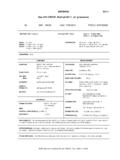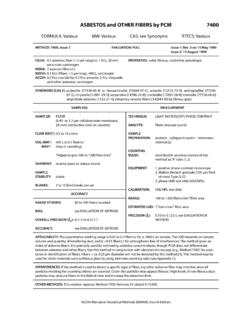Transcription of of Analytical Methods (NMAM), 5th Edition
1 DEPARTMENT OF HEALTH AND HUMAN SERVICES Centers for Disease Control and Prevention National Institute for Occupational Safety and Health niosh manual of Analytical Methods ( nmam ), 5th Edition Sampling and characterization of bioaerosols by William G. Lindsley, Brett J. Green, Francoise M. Blachere, Stephen B. Martin, Brandon F. Law, Paul A. Jensen and Millie P. Schafer, niosh BA-2 BA-5 BA-10 BA-28 BA-36 BA-39 BA-42BA-46BA-49BA-62BA-65BA-65BA-66BA-10 1 1 Introduction 2 Principles of bioaerosol collection 3 Devices used for bioaerosol sampling 4 Considerations for bioaerosol sampling 5 Selection of bioaerosol samplers 6 Sample preparation for culturable bioaerosols 7 Identification of culturable bioaerosols 8 Enumeration of culturable bioaerosols 9 Sample analysis Methods for non-viable and non-culturable bioaerosols 10 Limitations of bioaerosol sampling and characterization 11 Safety considerations 12 Resources 13 References 14 Appendix 1- List of manufacturers/distributors of common bioaerosol samplers and related products 15 Appendix 2
2 Commonly used bioaerosol samplers BA-104 niosh manual of Analytical Methods 5th Edition Chapter BA March 2017 Page BA-2 of BA-115 Sampling and Characterization of Bioaerosols 1 Introduction Bioaerosols are airborne particles that originate from biological sources including animals, plants, fungi, bacteria, protozoa, and viruses. Examples of bioaerosols encountered in occupational environments include plant pollen, algae, fungal spores, bacteria such as actinomycetes, droplets produced during coughing and sneezing that may contain bacteria and viruses, dust containing insect excreta, animal dander, and fragments derived from each of these sources. Bioaerosols are ubiquitous and can be isolated from indoor, outdoor, and occupational environments using a variety of Methods that either enumerate viable or a collection of viable and non-viable bioaerosols.
3 Photomicrographs of example viral, bacterial, fungal, and plant bioaerosols are presented in Figure 1. Bioaerosol monitoring is a rapidly emerging area of industrial hygiene due to the improved analysis Methods such as polymerase chain reaction (PCR) and the impact that occupational exposures may have on worker respiratory health, particularly in microbial contaminated environments [Eduard et al. 2012; Environment Agency 2009; Haig et al. 2016; Hung et al. 2005; Macher 1999; Morey 2007; Nazaroff 2016]. Some human diseases encountered in healthcare settings such as measles and tuberculosis can be spread by bioaerosols containing infectious microorganisms [Ijaz et al. 2016; Jones and Brosseau 2015]. Soil saprophytic fungi such as Coccidioides immitis can be aerosolized during occupational disturbance activities and, if inhaled, can result in an acute pulmonary infection [Das et al.]
4 2012; Wilken et al. 2014; Wilken et al. 2015]. The measurement of these bioaerosols in industrial hygiene includes the measurement of viable (culturable and non-culturable) and nonviable bioaerosols in indoor settings ( , industrial, office, education, and residential buildings), industrial facilities ( , biotechnology, composting, waste disposal, manufacturing, textile, and food processing), and outdoor environments ( , farms, feed lots, and general air quality). Monitoring for bioaerosols in the occupational environment is one of the many tools the industrial hygienist uses in the assessment of indoor air quality, infectious disease outbreaks, agricultural exposures, and industrial health. Bioaerosol monitoring may be appropriate during workplace health and exposure assessments, epidemiological investigations, research studies, or in situations deemed appropriate by an occupational physician or immunologist.
5 Sampling can also be used to evaluate occupational environments before and after mitigation of microbial contaminants. When investigating bioaerosols as a possible source of workplace exposures and health issues, bioaerosol sampling should be part of an integrated assessment of work conditions. This should also include examining heating, ventilation and air conditioning (HVAC) systems; checking for water infiltration and moisture control; evaluating microbial contamination in evaporative cooling systems, metal working fluids, and waste water; evaluating possible niosh manual of Analytical Methods 5th Edition Chapter BA March 2017 Page BA-3 of BA-115 Sampling and Characterization of Bioaerosols internal and external sources of bioaerosols; and other measures [Macher 1999].
6 In general, if visible growth or contamination (microbial growth on floors, walls, or ceilings, or in the HVAC system) is observed, this normally should be mitigated first before indoor bioaerosol sampling is conducted. If personnel remain symptomatic after remediation, air sampling may be appropriate, but the industrial hygienist should be aware that false negative results are possible and should be interpreted with caution. The industrial hygienist has a variety of tools and methodologies available to conduct an environmental survey [ASTM 2014a; Flannigan et al. 2011; Hung et al. 2005]. However, many of these approaches have lacked standardization and this has made the interpretation and comparison between studies challenging [Flannigan et al.]
7 2011]. In 2005, the American Industrial Hygiene Association (AIHA) published the second Edition of the Field Guide for the Determination of Biological Contaminants in Environmental Samples [Hung et al. 2005]. This reference provides the industrial hygienist access to the most up to date Methods to detect and quantify bioaerosols in the environment, and covers Methods of how to conduct a survey, sample bioaerosols, and interpret the collected data [Hung et al. 2005]. Similarly, other reference sources have been published by Flannigan et al. [2011] and the American Conference of Governmental Industrial Hygienists (ACGIH) [Macher 1999] that extensively outline available Methods to analyze collected bioaerosols as well as strategies to conduct an environmental survey.
8 ASTM International has issued a wide range of standards on indoor air quality, including assessment of fungal growth and collection of bioaerosols and a guide to developing an air sampling strategy [ASTM 2009; ASTM 2014a; ASTM 2014b; ASTM 2014d]. The European Committee for Standardization has also published standards on sampling for bioaerosols and related topics [CEN 2000; CEN 2003; CEN 2004]. The sections presented below provide a very broad overview of the viable and non-viable Methods available to detect bioaerosol sources that are described in the references listed above. niosh manual of Analytical Methods 5th Edition Chapter BA March 2017 Page BA-4 of BA-115 Sampling and Characterization of Bioaerosols Figure 1: Photomicrographs of acellular, prokaryotic and eukaryotic microorganisms that can be encountered in occupational or industrial environments.
9 (A) Transmission electron micrograph of Influenza/flu (H1N1) virus particles (Photo courtesy of National Institute of Allergy and Infectious Diseases; CDC Public Health Image Library (PHIL) ID#: 18156); (B) Scanning electron micrograph of bacilli derived from the Gram-negative bacteria, Legionella pneumophila (Photo courtesy of National Institute of Allergy and Infectious Diseases; CDC Public Health Image Library (PHIL) ID#: 11150); (C) Scanning electron micrograph of Aspergillus species reproductive structures including chains of asexual spores (Photo courtesy of CDC/ Robert Simmons; CDC Public Health Image Library (PHIL) ID#: 13367); and (D) Scanning electron micrograph of tricolpate pollen derived from the angiosperm plant species, Oenothera fruticosa (Photo courtesy of CDC/ Janice Carr, Betsy Crane; CDC Public Health Image Library (PHIL) ID#: 8729).
10 The CDC Public Health Image Library at has thousands of health-related images available to the public free of charge. niosh manual of Analytical Methods 5th Edition Chapter BA March 2017 Page BA-5 of BA-115 Sampling and Characterization of Bioaerosols 2 Principles of bioaerosol collection a. Aerodynamic diameter The aerodynamic diameter of an airborne particle (usually written as da or dae ) is the single most important parameter that determines how the particle will behave in the air, including how long it will stay airborne and where it will deposit in the respiratory system if inhaled. If a particle is falling in still air, it will reach an equilibrium velocity where the gravitational force pulling it downward is balanced by the drag force on its surface.












